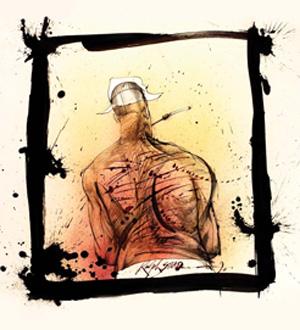ARCHIVE
Ralph Steadman on Dr. Hunter S. Thompson: Highlights from Issue 22: The Downfall of American Publishing
Highlights from Issue 22: The Downfall of American Publishing

Artwork by RALPH STEADMAN
Monday, August 01, 2005
What follows is an excerpt from Issue 22: The Downfall of American Publishing
This issue is available for purchase on this site
Ralph Steadman on Hunter S. Thompson
(EXCERPT)
It was through Steadman's illustrations that the world caught its first glimpse of Gonzo. Originally paired up with Thompson by Warren Hinckle of Scanlan's magazine in 1970, the duo's first collaboration, “The Kentucky Derby Is Decadent and Depraved," signified a point of no return. After the resounding success of Fear and Loathing in Las Vegas, published the following year, the potent mixture of Steadman's apocalyptic images and Thompson's hyperbolic prose forever tampered the bloodstream of conventional journalism.
Ralph Steadman: You know what I wish he'd done? I wish he'd shot himself through the bollocks and at least experienced the pain of it and wrote about it because his brain would still be there. He shot away the one thing we all respected and revered. Why did he have to shoot his box off? Shoot yourself through the foot — anything. The most expressive, most beautiful brain — there aren't many in a lifetime, you know? Think about that. Think about the unthinkable. The unthinkable is not shooting your brains out.
Anyone can shoot his brains out. It probably is the most painless way to go. Do you know he was a coward? The bastard was a coward. He had to be to shoot his brains out, but he was so good at it. He knew he could do it exactly and then he put a hole through the cooker hood in his kitchen.
If you look at the bullet hole, it could be a bullet hole anywhere. It's not really important, but these things become symbolic. They become so important to people. They want to know exactly how it happened. Did he suffer? Did it kill him instantly? Was he in desperate pain? How did he feel the moment before he died? Why didn't he make a quick recording of what he was thinking the moment before he did it? There is nothing.
Nothing exists.
*****
Hunter hid his sensitivity as though you would think he was a softie if he liked spring. He loved the spring. He loved the roaring river in Aspen. He loved being there. He loved seeing it, knowing it was there. He was a naturalist in that way. He loved the peacocks on his land. He loved living in the natural, being part of the natural. It's so important. If you just think he was a punk who tried to upset everything, you'd be wrong.
I've had 35 years of thinking like Hunter. It's a very hard business to think like Hunter.
After 35 years he taught me something: How to be rude to people and yet so gracious. He taught me how to be nice. The peculiar gonzo thing started with him and I. That was how it started, but I'm not going to argue that “I want to be remembered.” That is really not important. But I'm afraid that time will warp it. I just don't want the whole thing to be warped. I just can't bear it.
*****
Ralph Steadman's full interview — as well as HST oral histories from PJ O'Rourke, Douglas Brinkley, Bob Braudis and more — appears in Issue 22: The Downfall of American Publishing


